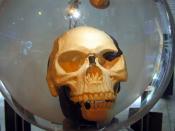Evolution: The Facts and the Fallacies
Deep within the isolated region of the dense, insect infested African jungle, a loathsome, four-legged creature, otherwise known as an ape, walks around his domain diligently seeking for food that his family might eat. Nearly two billion years later, that same creature, now a Homo habilis, occasionally alternates between the obvious four-legged fashion of walking and the two-legged mode and repeats the same action as the two billion years prior. Another million years, or so, the modern man, commonly known as a Homo Sapien, evolves, walking bipedal without any hesitation, preparing his dinner over an open fire. This is one of the many false, but accepted causes of the existence and evolution of life. For centuries man has pondered the very cause of the existence of life, and for centuries there has been no conclusive evidence from the theories. The many concepts of evolution have been extremely vague and entirely unprovable given the engulfing amount of scientific research and the conclusions it proves.
Despite the opposition from society and evolutionary institutions, evidence is rising that proves evolution isn't as true as it was once thought.
The epic proposals and evolutionary mechanisms begin with Lamarckism, "the theory of inheritance of acquired characteristics" (Huse 148). This theory, proposed by Jean-Baptiste de Lamarck (1744-1829), states that if a certain physical characteristic is not being used then evolution will eliminate its existence. However, if the characteristic is being used, then it will become more advanced as evolution proceeds (Huse 88). This theory first introduced the idea of organic evolution. This has been proven false, however, because these alterations can only be completed by surgically altering the DNA strands in one's genes, also know as genetic engineering, and, thus, passed on to the offspring (Huse 88).
Another interesting,



Very one-sided!
That may have been the point though of course, But I couldn't really tell.It seemed that the author trusted too many one-sided sources as well. There were some good valid points.But all'n'all I wouldn't recomend it.
5 out of 6 people found this comment useful.